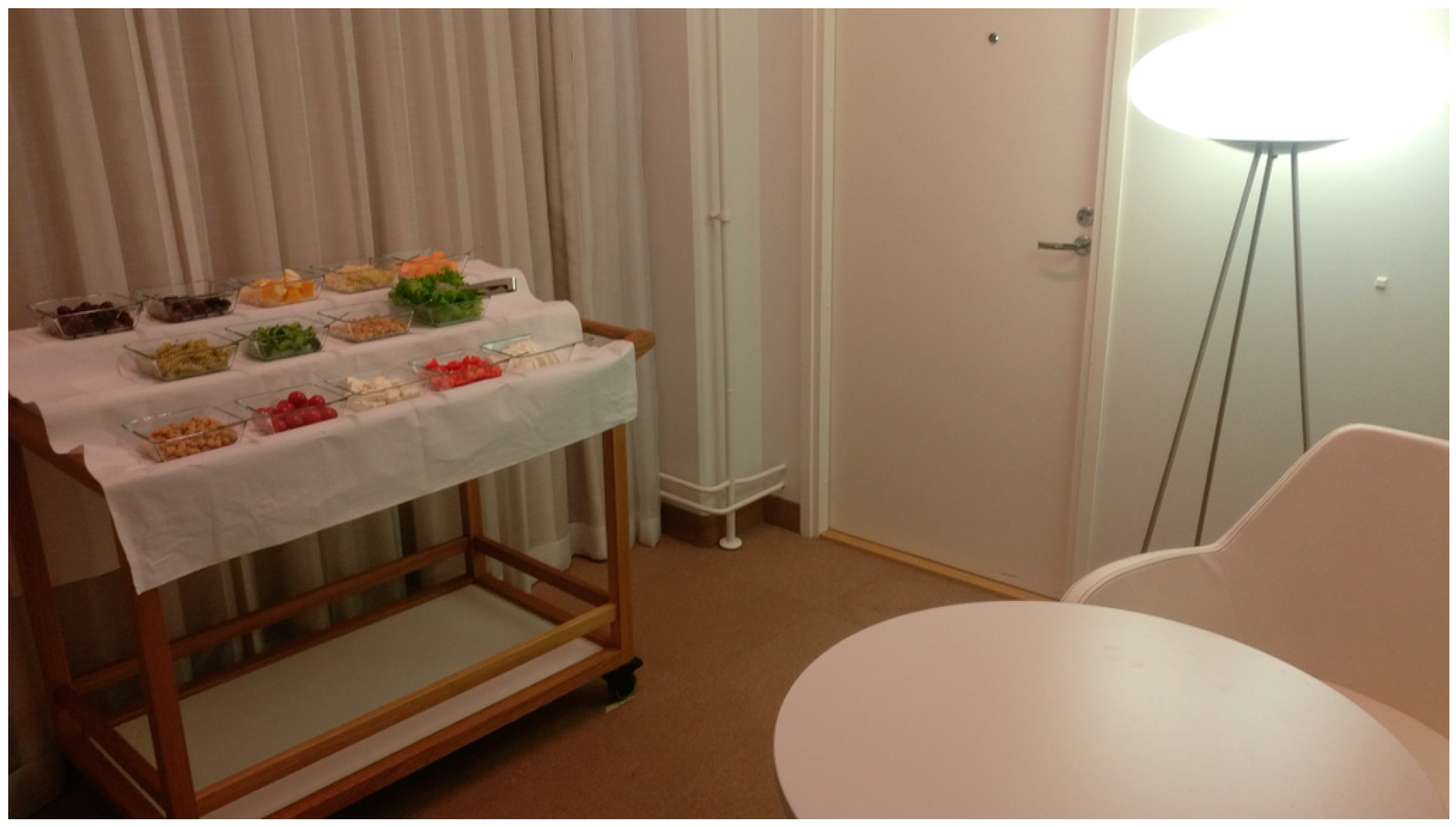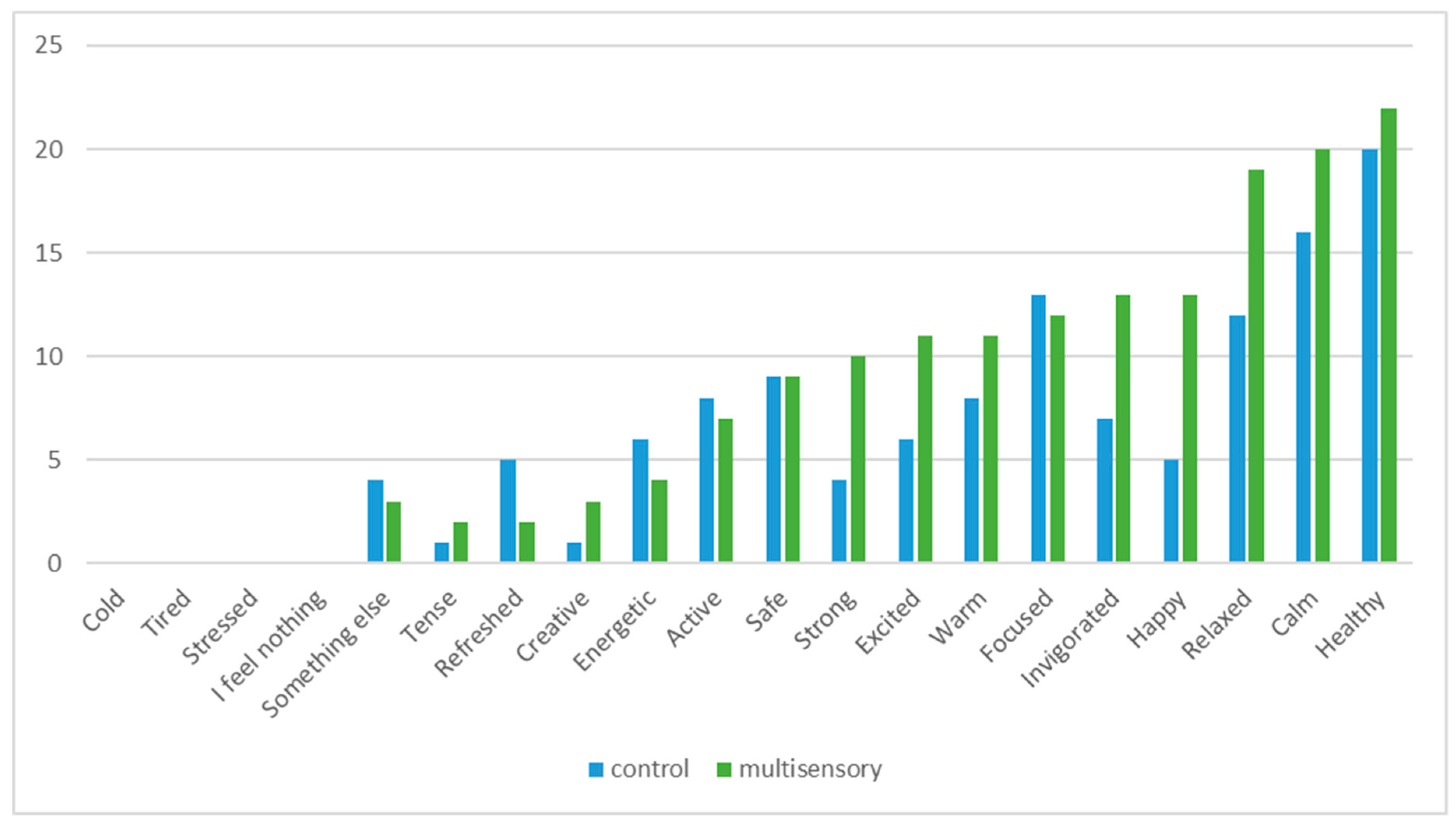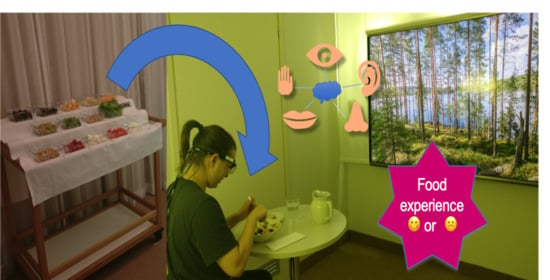Food Consumption and Emotions at a Salad Lunch Buffet in a Multisensory Environment
Abstract
1. Introduction
2. Methods
2.1. Subjects
2.2. Buffet Foods
2.3. Multisensory Laboratory Conditions
2.4. Questionnaire
2.5. Procedure
2.6. Statistics
3. Results
4. Discussion
Author Contributions
Funding
Acknowledgments
Conflicts of Interest
References
- Roos, E.; Sarlio-Lähteenkorva, S.; Lallukka, T. Having lunch at a staff canteen is associated with recommended food habits. Public Health Nutr. 2004, 7, 53–61. [Google Scholar] [CrossRef] [PubMed]
- Thorsen, A.V.; Lassen, A.D.; Tetens, I.; Hels, O.; Mikkelsen, B.E. Long-term sustainability of a worksite canteen intervention of serving more fruit and vegetables. Public Health Nutr. 2010, 13, 1647–1652. [Google Scholar] [CrossRef] [PubMed]
- Broers, V.J.V.; De Breucker, C.; Van den Broucke, S.; Luminet, O. A systematic review and meta-analysis of the effectiveness of nudging to increase fruit and vegetable choice. Eur. J. Public Health 2017, 27, 912–920. [Google Scholar] [CrossRef] [PubMed]
- Bellini, D.; Hartig, T.; Bonaiuto, M. Social support in the company canteen: A restorative resource buffering the relationship between job demands and fatigue. Work 2019, 63, 375–387. [Google Scholar] [CrossRef] [PubMed]
- Kontukoski, M.; Paakki, M.; Thureson, J.; Uimonen, H.; Hopia, A. Imagined salad and steak restaurants: Consumers’ colour, music and emotion associations with different dishes. Int. J. Gastron. Food Sci. 2016, 4, 1–11. [Google Scholar] [CrossRef]
- Barrett, D.M.; Beaulieu, J.C.; Shewfelt, R. Color, flavor, texture, and nutritional quality of fresh-cut fruits and vegetables: Desirable levels, instrumental and sensory measurement, and the effects of processing. Crit. Rev. Food Sci. Nutr. 2010, 50, 369–389. [Google Scholar] [CrossRef]
- Van Stokkom, V.L.; Blok, A.E.; van Kooten, O.; de Graaf, C.; Stieger, M. The role of smell, taste, flavour and texture cues in the identification of vegetables. Appetite 2018, 121, 69–76. [Google Scholar] [CrossRef]
- Spence, C. Multisensory flavor perception. Cell 2015, 161, 24–35. [Google Scholar] [CrossRef]
- Stelick, A.; Dando, R. Thinking outside the booth—The eating environment, context and ecological validity in sensory and consumer research. Curr. Opin. Food Sci. 2018, 21, 26–31. [Google Scholar] [CrossRef]
- Hathaway, D.; Simons, C.T. The impact of multiple immersion levels on data quality and panelist engagement for the evaluation of cookies under a preparation-based scenario. Food Qual. Prefer. 2017, 57, 114–125. [Google Scholar] [CrossRef]
- Bangcuyo, R.G.; Smith, K.J.; Zumach, J.L.; Pierce, A.M.; Guttman, G.A.; Simons, C.T. The use of immersive technologies to improve consumer testing: The role of ecological validity, context and engagement in evaluating coffee. Food Qual. Prefer. 2015, 41, 84–95. [Google Scholar] [CrossRef]
- Worch, T.; Sinesio, F.; Moneta, E.; Abba, S.; Dreyfuss, L.; McEwan, J.A.; Porcherot-Lassallette, C. Influence of different test conditions on the emotional responses elicited by beers. Food Qual. Prefer. 2020, 83, 103895. [Google Scholar] [CrossRef]
- Delarue, J.; Brasset, A.-C.; Jarrot, F.; Abiven, F. Taking control of product testing context thanks to multi-sensory immersive room. A case study on alcohol-free beer. Food Qual. Prefer. 2019, 75, 78–86. [Google Scholar] [CrossRef]
- Zandstra, E.H.; Kaneko, D.; Dijksterhuis, G.B.; Vennik, E.; De Wijk, R.A. Implementing immersive technologies in consumer testing: Liking and Just-About-Right ratings in a laboratory, immersive simulated café and real café. Food Qual. Prefer. 2020, 84, 103934. [Google Scholar] [CrossRef]
- Pennanen, K.; Närväinen, J.; Vanhatalo, S.; Raisamo, R.; Sozer, N. Effect of virtual eating environment on consumers’ evaluations of healthy and unhealthy snacks. Food Qual. Prefer. 2020, 82, 103871. [Google Scholar] [CrossRef]
- Kong, Y.; Sharma, C.; Kanala, N.; Thakur, M.; Li, L.; Xu, D.; Harrison, R.; Torrico, D.D. Virtual reality and immersive environments on sensory perception of chocolate products: A preliminary study. Foods 2020, 9, 515. [Google Scholar] [CrossRef]
- Lagast, S.; Gellynck, X.; Schouteten, J.J.; De Herdt, V.; De Steur, H. Consumers’ emotions elicited by food: A systematic review of explicit and implicit methods. Trends. Food. Sci. Technol. 2017, 69, 172–189. [Google Scholar] [CrossRef]
- Kaneko, D.; Toet, A.; Brouwer, A.M.; Kallen, V.; van Erp, J.B.F. Methods for evaluating emotions evoked by food experiences: A literature review. Front. Psychol. 2018, 9, 911. [Google Scholar] [CrossRef]
- Toet, A.; Kaneko, D.; Ushiama, S.; Hoving, S.; de Kruijf, I.; Brouwer, A.; Kallen, V.; van Erp, J.B.F. EmojiGrid: A 2D pictorial scale for the assessment of food elicited emotions. Front. Psychol. 2018, 9, 2396. [Google Scholar] [CrossRef]
- Dalenberg, J.R.; Gutjar, S.; ter Horst, G.J.; de Graaf, K.; Renken, R.J.; Jager, G. Evoked emotions predict food choice. PLoS ONE 2014, 9, e115388. [Google Scholar] [CrossRef] [PubMed]
- Gutjar, S.; de Graaf, C.; Kooijman, V.; de Wijk, R.A.; Nys, A.; ter Horst, G.J.; Jager, G. The role of emotions in food choice and liking. Food Res. Int. 2015, 76, 216–223. [Google Scholar] [CrossRef]
- Xu, Y.; Hamid, N.; Shepherd, D.; Kantono, K.; Spence, C. Changes in flavour, emotion, and electrophysiological measurements when consuming chocolate ice cream in different eating environments. Food Qual. Prefer. 2019, 77, 191–205. [Google Scholar] [CrossRef]
- Puputti, S.; Aisala, H.; Hoppu, U.; Sandell, M. Multidimensional measurement of individual differences in taste perception. Food Qual. Prefer. 2018, 65, 10–17. [Google Scholar] [CrossRef]
- King, S.C.; Meiselman, H.L. Development of a method to measure consumer emotions associated with foods. Food Qual. Prefer. 2010, 21, 168–177. [Google Scholar] [CrossRef]
- King, S.C.; Snow, J.; Meiselman, H.L.; Sainsbury, J.; Carr, B.T.; McCafferty, D.; Serranao, D.; Gillette, M.; Millard, L.; Li, Q. Development of a questionnaire to measure consumer wellness associated with foods: The WellSense profile. Food Qual. Prefer. 2015, 39, 82–94. [Google Scholar] [CrossRef]
- Wang, E.; Cakmak, Y.O.; Peng, M. Eating with eyes—Comparing eye movements and food choices between overweight and lean individuals in a real-life buffet setting. Appetite 2018, 125, 152–159. [Google Scholar] [CrossRef]
- Shafaie, Y.; Koelliker, Y.; Hoffman, D.J.; Tepper, B.J. Energy intake and diet selection during buffet consumption in women classified by the 6-n-propylthiouracil bitter taste phenotype. Am. J. Clin. Nutr. 2013, 98, 1583–1591. [Google Scholar] [CrossRef]
- Han, P.; Keast, R.; Roura, E. TAS1R1 and TAS1R3 polymorphisms relate to energy and protein-rich food choices from a buffet meal respectively. Nutrients 2018, 10, 1906. [Google Scholar] [CrossRef]
- Sinesio, F.; Saba, A.; Peparaio, M.; Saggia Civitelli, E.; Paoletti, F.; Moneta, E. Capturing consumer perception of vegetable freshness in a simulated real-life taste situation. Food Res. Int. 2018, 105, 764–771. [Google Scholar] [CrossRef]
- Friis, R.; Skov, L.R.; Olsen, A.; Appleton, K.M.; Saulais, L.; Dinnella, C.; Hartwell, H.; Depezay, L.; Monteleone, E.; Giboreau, A.; et al. Comparison of three nudge interventions (priming, default option, and perceived variety) to promote vegetable consumption in a self-service buffet setting. PLoS ONE 2017, 12, e0176028. [Google Scholar] [CrossRef]
- Gaillet-Torrent, M.; Sulmont-Rossé, C.; Issanchou, S.; Chabanet, C.; Chambaron, S. Impact of a non-attentively perceived odour on subsequent food choices. Appetite 2014, 76, 17–22. [Google Scholar] [CrossRef] [PubMed]
- Mors, M.R.; Polet, I.A.; Vingerhoeds, M.H.; Perez-Cueto, F.J.A.; de Wijk, R.A. Can food choice be influenced with priming with food odours? Food Qual. Prefer. 2018, 66, 148–152. [Google Scholar] [CrossRef]
- Spence, C.; Reinoso-Carvalho, F.; Velasco, C.; Wang, Q.J. Extrinsic auditory contributions to food perception & consumer behaviour: An interdisciplinary review. Multisens. Res. 2019, 32, 275–318. [Google Scholar] [CrossRef] [PubMed]
- Fiegel, A.; Meullenet, J.F.; Harrington, R.J.; Humble, R.; Seo, H.S. Background music genre can modulate flavor pleasantness and overall impression of food stimuli. Appetite 2014, 76, 144–152. [Google Scholar] [CrossRef]
- Ratcliffe, E.; Gatersleben, B.; Sowden, P.T. Bird sounds and their contributions to perceived attention restoration and stress recovery. J. Environ. Psychol. 2013, 36, 221–228. [Google Scholar] [CrossRef]
- Paakki, M.; Sandell, M.; Hopia, A. Visual attractiveness depends on colorfulness and color contrasts in mixed salads. Food Qual. Prefer. 2019, 76, 81–90. [Google Scholar] [CrossRef]
- Spence, C. Background color & its impact on food perception & behavior. Food Qual. Prefer. 2018, 68, 156–166. [Google Scholar] [CrossRef]
- Hoppu, U.; Puputti, S.; Aisala, H.; Laaksonen, O.; Sandell, M. Individual differences in the perception of color solutions. Foods 2018, 7, 154. [Google Scholar] [CrossRef]
- Schifferstein, H.N.J.; Howell, B.F.; Pont, S.C. Colored backgrounds affect the attractiveness of fresh produce but not it’s perceived color. Food Qual. Prefer. 2017, 56, 173–180. [Google Scholar] [CrossRef]
- Hasenbeck, A.; Cho, S.; Meullenet, J.F.; Tokar, T.; Yang, F.; Huddleston, E.A.; Seo, H.S. Color and illuminance level of lighting can modulate willingness to eat bell peppers. J. Sci. Food Agric. 2014, 94, 2049–2056. [Google Scholar] [CrossRef]
- Edwards, J.S.A.; Hartwell, H.J.; Brown, L. The relationship between emotions, food consumption and meal acceptability when eating out of the home. Food Qual. Prefer. 2013, 30, 22–32. [Google Scholar] [CrossRef]
- Piqueras-Fiszman, B.; Jaeger, S.R. Emotions associated to mealtimes: Memorable meals and typical evening meals. Food Res. Int. 2015, 76, 243–252. [Google Scholar] [CrossRef]
- Maksimainen, J.; Wikgren, J.; Eerola, T.; Saarikallio, S. The effect of memory in inducing pleasant emotions with musical and pictorial stimuli. Sci. Rep. 2018, 8, 17638. [Google Scholar] [CrossRef] [PubMed]
- Steinemann, A. Health and societal effects from exposure to fragranced consumer products. Prev. Med. Rep. 2016, 5, 45–47. [Google Scholar] [CrossRef] [PubMed]
- Bucher, T.; Keller, C. The web-buffet--development and validation of an online tool to measure food choice. Public Health Nutr. 2015, 18, 1950–1959. [Google Scholar] [CrossRef]
- König, L.M.; Renner, B. Boosting healthy food choices by meal colour variety: Results from two experiments and a just-in-time Ecological Momentary Intervention. BMC Public Health 2019, 19, 975. [Google Scholar] [CrossRef]
- Nørnberg, T.R.; Houlby, L.; Jørgensen, L.N.; He, C.; Pérez-Cueto, F.J. Do we know how much we put on the plate? Assessment of the accuracy of self-estimated versus weighed vegetables and whole grain portions using an Intelligent Buffet at the FoodScape Lab. Appetite 2014, 81, 162–167. [Google Scholar] [CrossRef]
- Haugaard, P.; Stancu, C.M.; Brockhoff, P.B.; Thorsdottir, I.; Lähteenmäki, L. Determinants of meal satisfaction in a workplace environment. Appetite 2016, 105, 195–203. [Google Scholar] [CrossRef]




| Food Color | Foods | Type, Preparation | Serving Size (g) |
|---|---|---|---|
| Black | Kalamata olive | canned, strained | 150 |
| Black grape | rinsed | 240 | |
| Green | Broccoli | frozen, defrosted | 180 |
| Ice lettuce | rinsed, ripped to pieces | 100 | |
| Red | Cherry tomato | rinsed | 240 |
| Red bell pepper | rinsed, chopped | 200 | |
| Beige | Chickpeas | canned, rinsed, strained | 240 |
| Salted peanuts | 140 | ||
| Orange | Orange | peeled, cut | 250 |
| Cantaloupe melon | peeled, cut | 200 | |
| White | Mozzarella cheese | cut into slices | 240 |
| Feta-type cheese | cubes, strained | 210 | |
| Pasta | Pesto pasta | cooked pasta, cooled, mixed with pesto sauce 1:7 | 205 |
| Aioli pasta | cooked pasta, cooled, mixed with aioli mayonnaise 1:7 | 205 |
| Food | Food Intake Control (g) Mean (SD) | Food Intake Multisensory (g) Mean (SD) |
|---|---|---|
| Kalamata olive | 14 (13) | 14 (14) |
| Black grape | 25 (18) | 29 (16) |
| Broccoli | 32 (21) | 31 (22) |
| Ice lettuce | 22 (13) | 21 (14) |
| Cherry tomato | 38 (24) | 35 (22) |
| Red bell pepper | 20 (17) | 19 (17) |
| Chickpeas | 17 (24) | 15 (19) |
| Salted peanuts | 7 (8) | 7 (7) |
| Orange | 38 (30) | 33 (27) |
| Cantaloupe melon | 43 (25) | 38 (19) |
| Mozzarella cheese | 36 (22) | 32 (22) |
| Feta-type cheese | 30 (20) | 28 (18) |
| Pesto pasta | 34 (27) | 35 (29) |
| Aioli pasta | 14 (17) | 16 (25) |
| Total weight of the portion | 372 (98) | 354 (100) |
© 2020 by the authors. Licensee MDPI, Basel, Switzerland. This article is an open access article distributed under the terms and conditions of the Creative Commons Attribution (CC BY) license (http://creativecommons.org/licenses/by/4.0/).
Share and Cite
Hoppu, U.; Puputti, S.; Mattila, S.; Puurtinen, M.; Sandell, M. Food Consumption and Emotions at a Salad Lunch Buffet in a Multisensory Environment. Foods 2020, 9, 1349. https://doi.org/10.3390/foods9101349
Hoppu U, Puputti S, Mattila S, Puurtinen M, Sandell M. Food Consumption and Emotions at a Salad Lunch Buffet in a Multisensory Environment. Foods. 2020; 9(10):1349. https://doi.org/10.3390/foods9101349
Chicago/Turabian StyleHoppu, Ulla, Sari Puputti, Saila Mattila, Marjaana Puurtinen, and Mari Sandell. 2020. "Food Consumption and Emotions at a Salad Lunch Buffet in a Multisensory Environment" Foods 9, no. 10: 1349. https://doi.org/10.3390/foods9101349
APA StyleHoppu, U., Puputti, S., Mattila, S., Puurtinen, M., & Sandell, M. (2020). Food Consumption and Emotions at a Salad Lunch Buffet in a Multisensory Environment. Foods, 9(10), 1349. https://doi.org/10.3390/foods9101349







